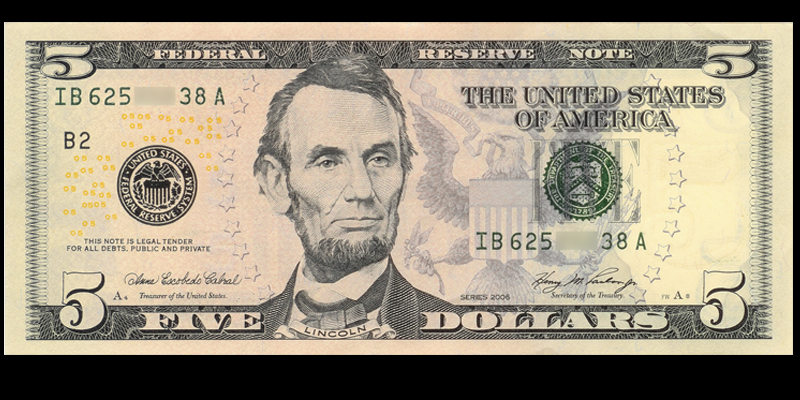Have you seen the above commercial where Burger King is pretending to start a campaign to change the design of the five dollar bill? The joke is that they want to redo the currency to use an image of Abraham Lincoln holding two burgers.
The commercial is kind of dumb (especially with the bad fake laughter from the so called focus group panel), but it got me thinking…who decides the images featured on US currency?
Let’s tackle that question in today’s edition of Wonder Why Wednesday.
Who decides on the designs used in US currency?
The answer is Jacob J. Lew.
According to the U.S. Department of the Treasury, the Secretary of the Treasury usually selects the designs shown on United States currency. “Unless specified by an Act of Congress, the Secretary generally has the final approval. This is done with the advice of Bureau of Engraving and Printing officials.”
Jacob J. Lew is the current Secretary of the Treasury, so I guess it will be up to him to determine the fate of the five dollar Burger King bill.
When making such a decision, Mr. Lew has one rule to follow. Law prohibits portraits of living persons from appearing on currency. Which is why the images on our current bills are all of deceased famous Americans.
Even though Mr. Lew has the final say, he has not had to use this power. The Department of the Treasury says “that the front and back designs of all denominations of our paper currency in circulation today were selected in 1928, although they were modified to improve security against counterfeiting starting in 1996. A committee appointed to study such matters made those choices. The only exception is the reverse design of the one-dollar bill. Unfortunately, however, our records do not suggest why certain Presidents and statesmen were chosen for specific denominations.”
It is too bad that no one knows why certain people were chosen for specific denominations. That was going to be my next question.
Even though we don’t know why certain folks were picked, here is a list of everyone and everything featured on U.S. paper currency, compliments of MoneyFactor.gov.
- $1 Note (Face) – George Washington (1st U.S. President) (Back) – The Great Seal of the United States
- $2 Note (Face) – Thomas Jefferson (3rd U.S. President) (Back) – The Declaration of Independence
- $5 Note (Face) – Abraham Lincoln (16th U.S. President) (Back) – Lincoln Memorial
- $10 Note (Face) – Alexander Hamilton (1st Secretary of the Treasury) (Back) – U.S. Treasury Building
- $20 Note (Face) – Andrew Jackson (7th U.S. President) (Back) – White House
- $50 Note (Face) – Ulysses Grant (18th U.S. President) (Back) – U.S. Capitol
- $100 Note (Face) – Ben Franklin (Statesman) (Back) – Independence Hall
- $500 Note* (Face) – William McKinley (25th U.S. President) (Back) – Numeral 500 and the ornamental phrase “Five Hundred Dollars”
- $1000 Note* (Face) – Grover Cleveland (22nd & 24th U.S. President) (Back) – Numeral 1000 and the ornamental phrase “One Thousand Dollars”
- $5000 Note* (Face) – James Madison (4th U.S. President) (Back) – Numeral 5000 and the ornamental phrase “Five Thousand Dollars”
- $10,000 Note* (Face) – Salmon Chase (U.S. Treasury Secretary under Lincoln) (Back) – Numeral 10,000 and the ornamental phrase “Ten Thousand Dollars”
- $100,000 Note* (Face) – Woodrow Wilson (28th U.S. President) (Back) – Numeral 100,000 and the ornamental phrase “One Hundred Thousand Dollars”. This note never appeared in general circulation, and was only used in transactions between Federal Reserve Banks
* = Notes no longer in print or circulation
How many of those could you name?
I bet you couldn’t name that the $10,000 bill featured the image of Salmon Chase.
Chase was the U.S. Treasury Secretary under Abraham Lincoln. As we learned earlier, the Secretary of the Treasury selects the designs shown on United States currency. Before you start to think that Mr. Chase picked himself to be on the $10,000 bill, remember that the image on currency cannot be of anyone still living. Chase died in 1873 and his image was not used on currency until 1928.
Fun fact: Chase was instrumental in placing the phrase “In God We Trust” on United States coins in 1864.
Fun fact #2: The Chase National Bank, a predecessor of Chase Manhattan Bank which is now JPMorgan Chase was named in his honor, though he had no financial affiliation with it.
Photo credit: Wikipedia




